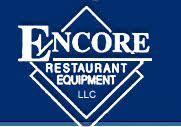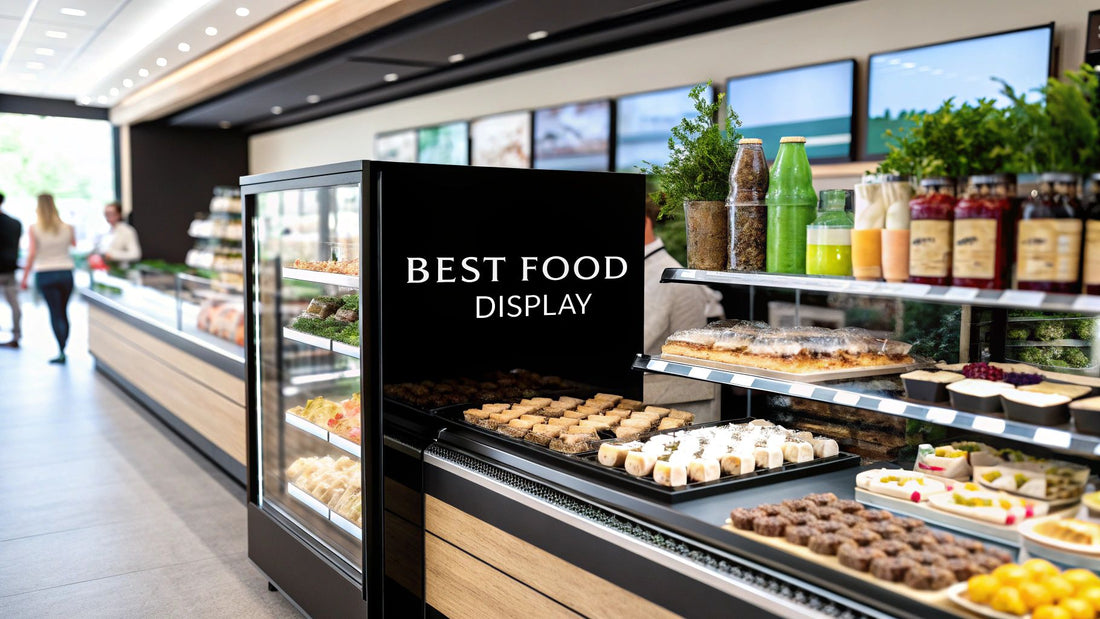
Choosing Your Best Food Case Display
Share
Your food case display isn't just a piece of equipment; it's your silent salesperson, a critical link between your kitchen and your customers. It’s what keeps your deli meats fresh, your rotisserie chickens perfectly warm, and your croissants looking irresistible. For savvy restaurant owners and chefs, choosing the right display is a strategic decision that impacts sales, food quality, and operational efficiency. Staying informed on industry trends and equipment innovations is key to making the best choice.
Matching Your Menu to the Right Display Case
Choosing a food case display is far more than finding a box that fits your space. The wrong choice can ruin food quality, kill your presentation, and cost you sales. The first step is to match the case's features to what you're actually selling, keeping an eye on the latest trends in restaurant equipment to ensure you're making a future-proof investment.
The Core Display Case Types
Different foods need completely different holding environments to stay fresh and appetizing. For instance, the high-humidity case that keeps your sliced turkey moist would turn a crusty baguette into a soggy mess. The gentle heat perfect for a soft pretzel would dry out a delicate croissant in no time.
Getting a handle on the main categories is your first step:
- Refrigerated Cases: These are your go-to for anything perishable that needs to be kept cool for safety. We're talking deli meats, cheeses, prepared salads, and anything with cream or custard.
- Heated Cases: Essential for grab-and-go hot items. Think rotisserie chickens, hot sandwiches, or pizza slices. They're designed to hold food at a safe and delicious temperature.
- Ambient (Non-Refrigerated) Cases: These simply protect food from sneezes and dust while showing it off. They’re perfect for items that are stable at room temperature, like breads, cookies, donuts, and muffins.
- Dual-Zone Cases: The ultimate space-saver. These units combine heated and refrigerated (or ambient) sections in one footprint. They're a fantastic solution if you have a varied menu but not a lot of floor space.
To give you a clearer picture of what works best for specific items, here’s a quick-reference table. It's a simple guide to help you match your food to the right kind of display, ensuring everything stays as fresh and visually appealing as possible.
Food Case Display Types and Best Uses
| Food Category | Recommended Display Type | Key Feature to Look For |
|---|---|---|
| Deli Meats & Cheeses | Refrigerated Deli Case | High-humidity, gravity coil system to prevent drying. |
| Cakes & Pastries | Refrigerated Bakery Case | Adjustable shelving and excellent lighting. |
| Packaged Drinks & Salads | Refrigerated Grab-and-Go | Open-air curtain or easy-access doors. |
| Hot Sandwiches & Pizza | Heated Display Case | Humidity controls to keep bread from getting tough. |
| Rotisserie Chicken | Heated Display Case | Consistent, even heating and good visibility. |
| Breads & Bagels | Ambient Bakery Case | Good ventilation to maintain crust. |
| Donuts & Cookies | Ambient Countertop Case | Full-service or self-service door options. |
This table should get you started, but always think about the specific needs of your signature items before making a final decision.
This infographic shows just how common each type of case is across the industry.
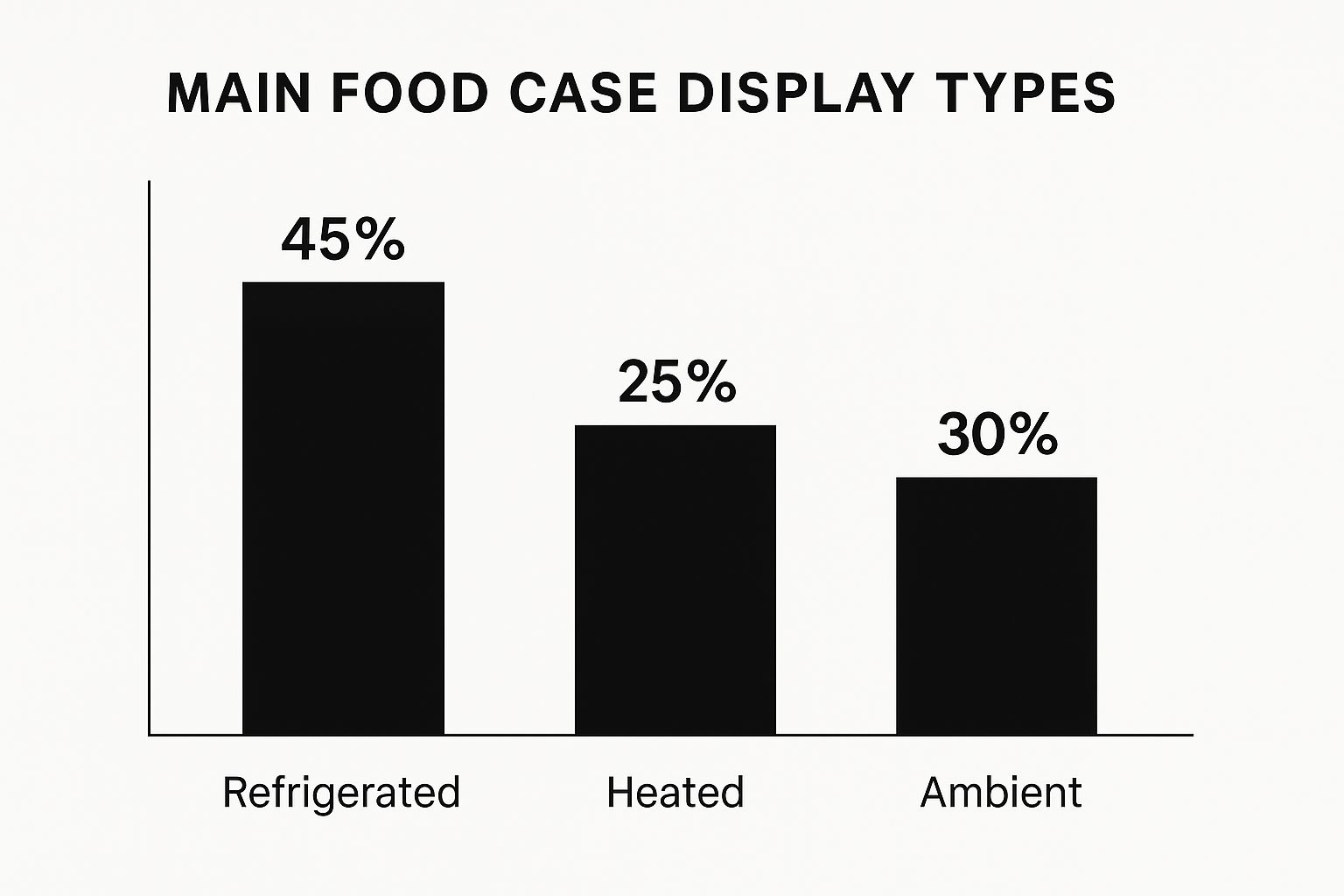
As you can see, refrigerated displays make up a huge chunk of the market, which makes sense given how many businesses rely on showcasing perishable goods safely and attractively.
A Pro Tip From Experience: Don't just look at temperature. Humidity control is a game-changer. High-humidity gravity coil systems are a must for things like fresh meat or delicate cakes because they stop them from drying out. On the other hand, forced-air systems are great for packaged goods but can be a disaster for exposed foods.
The demand for convenient, ready-to-eat meals that look fantastic is pushing this market forward. In fact, the food display cabinet market is set to grow from USD 21.48 billion in 2024 to an expected USD 23.54 billion in 2025—that's a 9.6% jump in just one year. You can dive deeper into food display market trends to see where the industry is heading.
Strategic Sizing and Placement for Sales
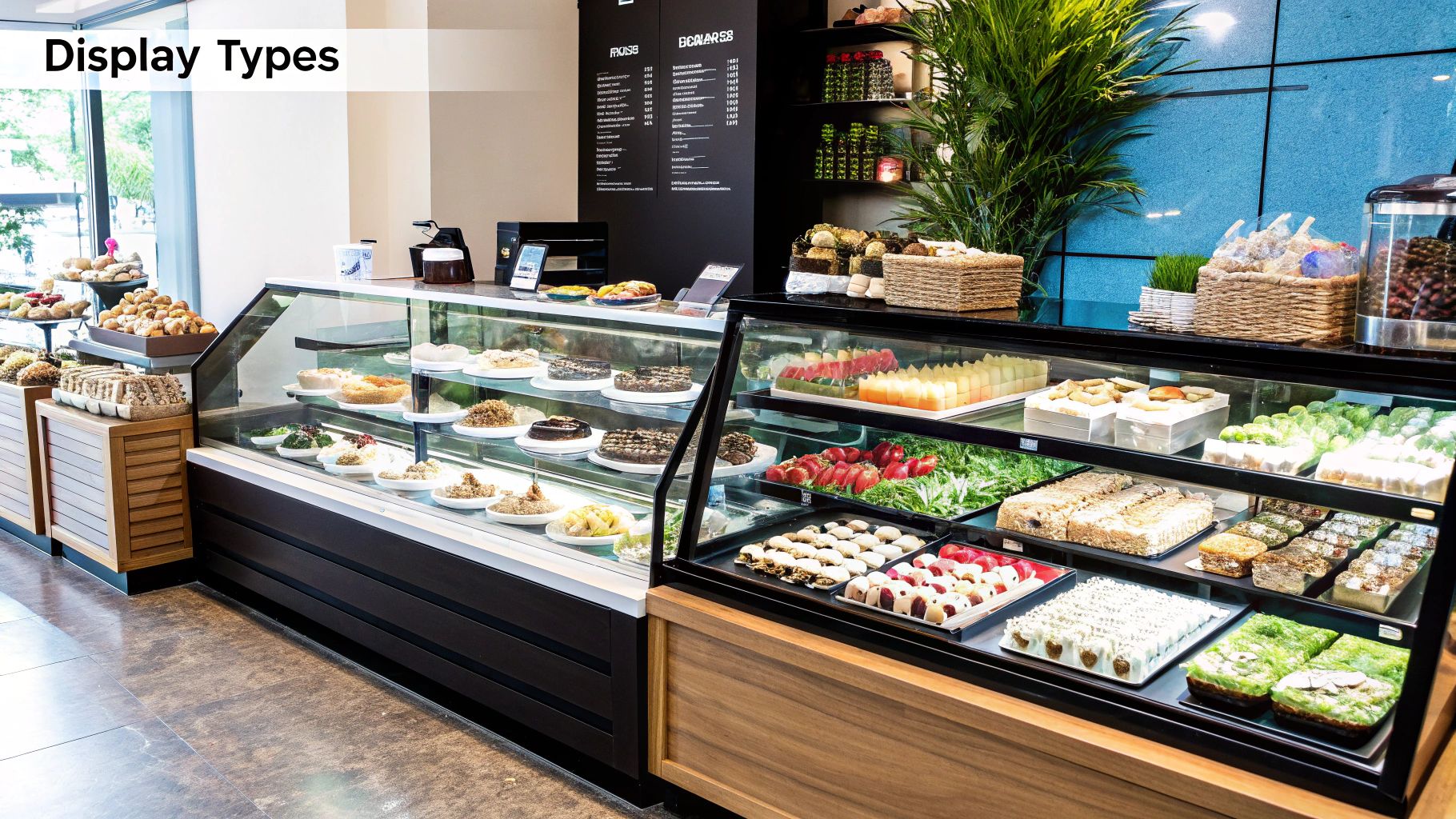
The size and placement of your food case display are every bit as important as what’s inside. It’s easy to focus on temperature and lighting, but where you put the unit directly impacts customer flow, what they see, and ultimately, what they buy. This isn't just about finding a spot where it fits; it's a sales strategy.
Think about it. A small countertop unit right by the register is a classic, effective way to drive impulse buys on drinks and desserts. On the other hand, a big, beautiful curved floor model can become the centerpiece of your deli or cafe, guiding customers through the space while showing off your best high-margin sandwiches and salads. The right placement turns a simple piece of equipment into a powerful sales tool.
Assessing Your Space
Before you pull the trigger on a purchase, you need to get real about the space you have. And I don’t just mean measuring the footprint. A case that technically fits can quickly become a nightmare if it creates a bottleneck or blocks access.
Here are a few things I always tell clients to check before they buy:
- Door Swing Clearance: Can the service doors open all the way without hitting a wall, another piece of equipment, or blocking a path? You need this for smooth restocking and cleaning. Don’t eyeball it—measure it.
- Ventilation Needs: Refrigerated cases need to breathe. Most require several inches of clearance around the back and sides for the compressor to work efficiently. Skimping on this is asking for higher energy bills and a shorter lifespan for your unit.
- Daily Cleaning Access: Your team has to be able to get to every nook and cranny—the glass, the interior shelves, and the floor around it. If cleaning is a hassle, it won't get done right, and that's a health code violation waiting to happen.
I once saw a busy deli dramatically speed up service by moving its main display case. They positioned it right between the slicer and the sandwich prep line, which cut down on wasted steps and got orders out faster. That's the kind of smart thinking that makes a difference.
This kind of strategic placement is a huge part of running an efficient kitchen. In fact, your entire equipment layout is foundational to success. For a deeper dive, check out our guide on commercial kitchen design layout to help you plan your space for peak performance.
What to Look for Inside: Essential Features That Protect Products and Profits

While the look of your display case grabs a customer's attention, it's the technology inside that truly keeps your products safe and your business profitable. The right features are about much more than just hitting a target temperature; they preserve food quality, minimize waste, and ultimately boost your sales. Savvy chefs look for these details when sourcing their restaurant supplies.
Think about lighting. It’s not just there to help people see. Modern LED lighting is now the industry go-to because it's energy-efficient and, crucially, doesn't radiate heat that can spoil your food. You can even choose specific color temperatures—some make red meats look richer, while others give pastries that perfect golden-brown glow. It’s a subtle detail that can make a huge difference in how appealing your items look.
Keeping It Fresh and Flexible
I’ve seen many operators underestimate the power of humidity control. For delicate items like intricate desserts or fresh salads, a high-humidity case is a game-changer. It stops them from drying out, which means less product in the trash and more satisfied customers.
Another feature offering incredible flexibility is dual-temperature zones. This lets you display chilled beverages right next to warm sandwiches, all within a single unit. It’s a fantastic way to maximize your offerings, especially if you're short on space.
This push for better preservation technology is driving major growth. The bakery case market alone is projected to jump from USD 10.1 billion in 2025 to USD 16.5 billion by 2035, largely thanks to these kinds of innovations.
A high-efficiency compressor might cost more upfront, but believe me, it pays for itself over time. You’ll see the savings on your utility bills, and they're far more reliable, which can save you from the headache and cost of emergency repair calls. Keep an eye out for exclusive deals on energy-efficient models.
Don't forget the practical, day-to-day stuff. Consider your workflow. Will sliding doors work better in your tight, self-serve space, or do you need hinged doors for quick, full access from behind the counter? Make sure the core materials, like stainless steel and tempered glass, are built for the long haul and are easy to keep sanitized.
These features aren't just specs on a data sheet; they're the foundation of a successful food display strategy. Making the right choices here is just as important as any other equipment decision. To make sure you've got all your bases covered, our commercial kitchen equipment checklist is a great resource.
Getting It Set Up and Keeping It Running for Years
A new food case is a serious investment, and you'll only get your money's worth with a solid setup and consistent care. Getting the installation right from the start heads off a lot of performance headaches down the road. A simple daily maintenance routine will then keep it humming along, extending its life and saving you from those dreaded emergency repair bills.
The setup process is a bit more involved than just finding an outlet and plugging it in. First things first, get a level and make sure the unit is perfectly flat. If it's tilted, even slightly, the doors might not seal correctly. That small gap leads to condensation and makes the compressor work way harder than it needs to.
Next, give it some breathing room. Most display cases need several inches of clearance around the back and sides to properly vent heat. Suffocating the unit by pushing it flush against a wall is a surefire way to overwork the refrigeration system and burn it out prematurely. And of course, double-check that you have the right dedicated electrical circuit to handle the load without causing issues.
A Simple Routine for Daily and Weekly Care
Once your display case is up and running, a little bit of daily attention is your best friend. It’s what stands between you and an unexpected breakdown or, worse, a health code violation. These checks don't take long, but they are absolutely essential for any professional chef or restaurant owner.
Here’s a practical routine you can easily build into your daily closing procedures:
- Daily Glass Cleaning: Nobody wants to buy food they can't see clearly. Use a food-safe glass cleaner and a good microfiber cloth to get a streak-free shine that makes your products pop.
- Wipe-Down and Sanitize: At the end of the day, all interior and exterior surfaces need a thorough wipe-down and sanitization. This isn't just for looks; it's a critical food safety step.
- Weekly Debris Removal: Take a moment each week to clear out crumbs and gunk from door tracks and gaskets. A clean seal is an efficient seal.
Here's a pro tip that gets missed all the time: check the condenser coils. They act like a magnet for dust, grease, and all sorts of kitchen grime. When they get clogged, the unit can't cool effectively. A quick cleaning every 90 days can single-handedly prevent the number one cause of compressor failure.
Turning Browsers Into Buyers With Smart Merchandising
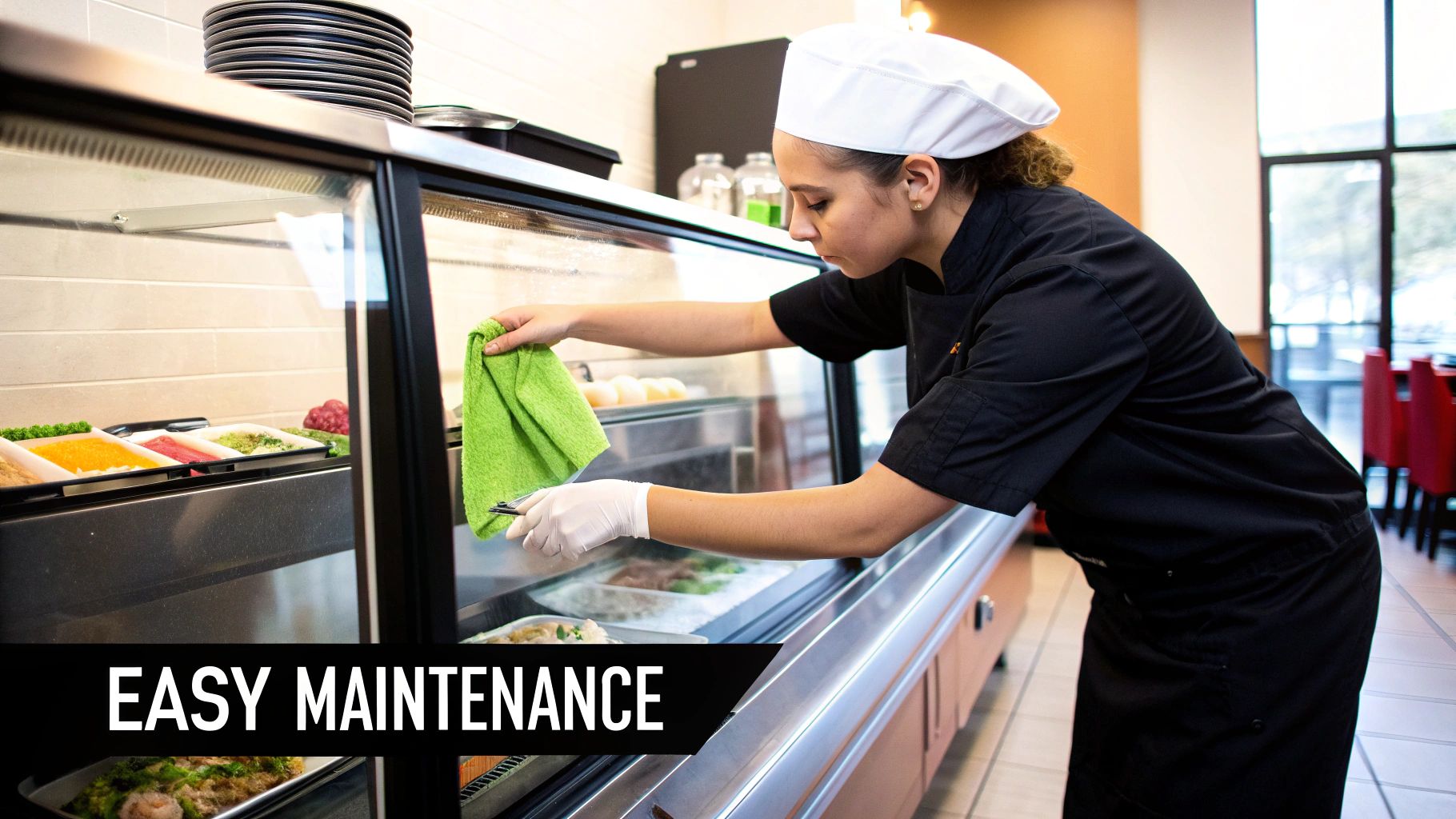
Alright, your display case is installed and running like a dream. Now for the fun part: making it work for you. Merchandising is more than just loading shelves; it's the art of turning a casual glance into a sale. This is where your display case stops being a refrigerator and starts being your silent salesperson.
The goal? Create a visual feast that stops customers in their tracks and nudges them toward an impulse buy. You can do this by playing with color, height, and texture to create focal points that draw the eye. Think about placing vibrant fruit tarts next to rich chocolate tortes—the contrast alone is compelling.
Creating an Irresistible Display
I’ve learned a few psychological tricks over the years, and one of the most effective is placing your highest-margin items right at eye level. That’s the prime real estate in your display. Use your best, brightest lighting to spotlight these key products, making them absolutely pop. Good lighting doesn’t just make food look good; it signals freshness and quality, which builds trust.
Merchandising is about telling a story with your food. Group complementary items together—think fresh-baked bread next to deli meats or decadent pastries near your grab-and-go coffee station. It helps customers imagine a complete meal, making it easier for them to buy more than one thing.
Heated cases, especially, are a goldmine for grab-and-go meals. They're not just for keeping things warm; they're essential for meeting the massive consumer demand for quick, quality food. Modern food warmer displays are more energy-efficient and better designed than ever, helping you nail food safety while showing off steaming-hot, delicious-looking meals. You can dig deeper into the latest trends in the food warmer display case market to see what's new.
Finally, don’t forget the details. Clear, attractive labels with prices and key ingredients help customers decide quickly and confidently. A clean, well-organized, and beautifully arranged food case doesn't just display your food—it actively sells it for you.
Answering Your Top Questions
Even the most seasoned chefs and operators run into questions when buying and using a food case display. It’s completely normal. Having a go-to resource for quick, reliable answers can make all the difference, helping you make the right call and keep your equipment in top shape.
Let’s talk about one of the most common headaches: condensation. You know the drill—you’ve staged your food perfectly, but the glass is all fogged up. This happens when the warm, humid air in your restaurant meets the cold glass of your display case. It doesn’t just block the view; it forces your refrigeration system to work overtime, which you’ll definitely notice on your energy bill.
Common Problems and Quick Fixes
From foggy glass to flickering lights, some issues seem to pop up more than others. Let's get straight to the point with some practical fixes for the problems we hear about most often.
We've put together a quick FAQ table to tackle these common head-scratchers. Think of it as your cheat sheet for keeping your display case running smoothly.
Common Food Case Display Questions
Find quick answers to frequently asked questions about food case displays.
| Question | Answer |
|---|---|
| How often should I clean the condenser coils? | As a rule of thumb, check and clean them at least every 90 days. But if you're in a high-dust or high-grease environment—like a bakery or a busy kitchen line—you'll want to do this monthly to keep the unit efficient and prevent a costly compressor failure. |
| What's the best lighting for making food look good? | Hands down, it’s LED lighting. It’s incredibly energy-efficient and doesn't throw off heat that could compromise food safety. For the best results, look for LEDs with a high Color Rendering Index (CRI) of 90+. This will make the natural colors of your food really stand out. |
| Can I use a deli case for pastries? | You can, but I wouldn't recommend it. Deli cases use high-velocity fans that are great for meats and cheeses but will dry out delicate items like croissants and cakes in no time. A dedicated bakery case with gravity coil refrigeration is a much better investment for maintaining that perfect texture and moisture. |
After looking at those common issues, it's clear that a little preventative care goes a long way.
A Critical Takeaway: Foggy glass isn't just an aesthetic issue—it's a bright red flag for an efficiency problem. When you see persistent condensation, it means your unit is working way too hard, leading to higher energy bills and potential spoilage.
So much of this comes down to understanding the simple mechanics of your equipment. Even something as small as a tiny gap in a door gasket can let in enough humid air to cause frost and block the view of your products.
For a deeper dive into our products, policies, and services, our frequently asked questions page is packed with information to help you manage all your restaurant equipment.
Ready to find a food case display that not only protects your food but also helps sell it? The team at Encore Seattle Restaurant Equipment has decades of hands-on experience helping restaurant owners and chefs across the Pacific Northwest. We stay informed about the latest industry trends and can help you discover exclusive deals on the restaurant equipment and supplies you need. We've seen it all and can guide you to the right solution. Check out our huge selection of new and used equipment online or stop by our Seattle showroom.
